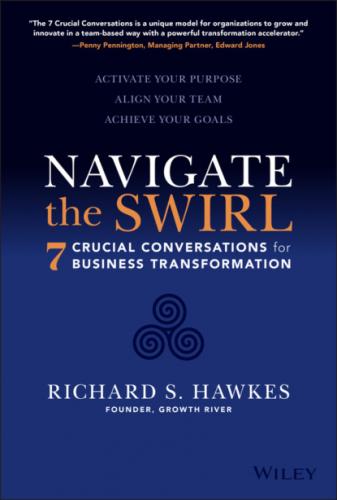Navigate the Swirl. Richard Hawkes
refers to thinking about time as a limited resource that is allocated to tasks and constrained by resources. Chronos meetings have clear agendas and a tight schedule so that everything can be covered.
Kairos, on the other hand, is what happens when we immerse ourselves in crucial conversations around goals and realities. Participants work together, helping each other process complex topics and accelerate thinking. They study, listen, sense, design, choose, align, all following the conversational landscape together. Complex topics can require multiple Kairos meetings, with breaks between, to arrive at a breakthrough, reach a decision, and align a commitment.
Every team needs a healthy balance between Chronos and Kairos. If you spend too much time on Chronos, you'll never grow and scale a company. On the other hand, if you spend too much time in Kairos, you'll never grow and scale a company.
The Engine of a Business
I have been amazed to see the power of the Business Triangle to effectively cut through the seeming complexity of a large enterprise, clarifying the confusion of roles, sorting out overlapping responsibilities, and revealing essential interdependencies. This, in turn, helps catalyze the right conversations to create clarity and alignment. Over time, I've only come to appreciate the power of this model more deeply—in small, medium, and large organizations. In later chapters, I will show how the natural creative tensions between the different sides of the triangle, often a source of crippling conflict, can be leveraged as a source of innovation. It's rare that I work with a business with which, sooner or later, there isn't a significant “aha” moment when the business team realizes how truly tangled its system of capabilities and roles is, which is fueling the Swirl and stymying growth.
The Business Triangle is like the engine of a business. It works best when everything is flowing smoothly around the various functions from Develop to Sell to Deliver without major blockages or confusion. Value creation flows from the original conception and creation of the product or service all the way to the customer, and then there is a feedback chain, coming back from the customer into the Develop part of the business. And around the triangle we go (see Figure 2.4). Meanwhile, our support functions are doing just that—supporting. And the customer is always in sight.
FIGURE 2.4 The Business Triangle in Action
Indeed, the Business Triangle provides a model of the business that always keeps serving the target customer's needs as a core objective, and aligning the business social system to work interdependently as the solution path. It sounds simple, but in practice, most organizations struggle to identify problems and resolve gaps in their system of roles fast enough to keep up with the needs of an evolving business. When we have the Business Triangle as a simple, shared language with which to discuss who the target customer is for each type of business capability, and what roles are going to own those capabilities, it becomes so much easier to shorten the distance between a problem or a breakdown and an elegant solution and resolution.
And, perhaps most importantly, the Business Triangle provides a model for organizing and growing a business that engages the social system and respects people's natural agency. It doesn't try to slot people into a mechanistic process; it allows them to see what they are in together and negotiate their roles within that system. This is essential for successfully navigating the difficult org structure conversations that come up in (and too often derail) any transformational journey. It provides an empowering and liberating shared language that clarifies priorities and reveals possibilities for optimizing how your business creates value as a team. It's visually clarifying. It boils the essential elements of your business down to a system of capabilities and roles, which then sets the stage for mapping and managing all the critical activities in a business through clear accountabilities. In sum, it allows us to model the seeming complexity of everything that goes on in a business. Throughout the journey of growth that we'll be exploring in this book, this model will be an essential tool. It doesn't capture everything about the nature of an organization or enterprise but it is a critical element in the shared language we are developing. As we bring clarity and transparency to the social system of an organization, the confusion of the Swirl recedes, and we set the stage for the crucial conversations that follow.
Now that we've unpacked and modeled the definition of a business, let's turn to a final framing question: What is growth? In terms of the model I've just shared, there's a simple answer: business growth is an acceleration in the velocity of value created around the Business Triangle. Indeed, the throughput around the triangle from Develop, to Sell, to Deliver will determine the speed of growth—for the business or businesses. However, as I've defined it in these pages, an organization is also much more than a business, and one organization can contain many businesses. So if an organization is a complex, adaptive social system and can contain one or more businesses, what does it mean for all of that to grow? And just as important, what might prevent it from doing so?
Note
1 1 Craig Roth, “2019: When We Exceeded 1 Billion Knowledge Workers,” Gartner blog post, December 11, 2019, https://blogs.gartner.com/craig-roth/2019/12/11/2019-exceeded-1-billion-knowledge-workers/.
Конец ознакомительного фрагмента.
Текст предоставлен ООО «ЛитРес».
Прочитайте эту книгу целиком, купив полную легальную версию на ЛитРес.
Безопасно оплатить книгу можно банковской картой Visa, MasterCard, Maestro, со счета мобильного телефона, с платежного терминала, в салоне МТС или Связной, через PayPal, WebMoney, Яндекс.Деньги, QIWI Кошелек, бонусными картами или другим удобным Вам способом.
